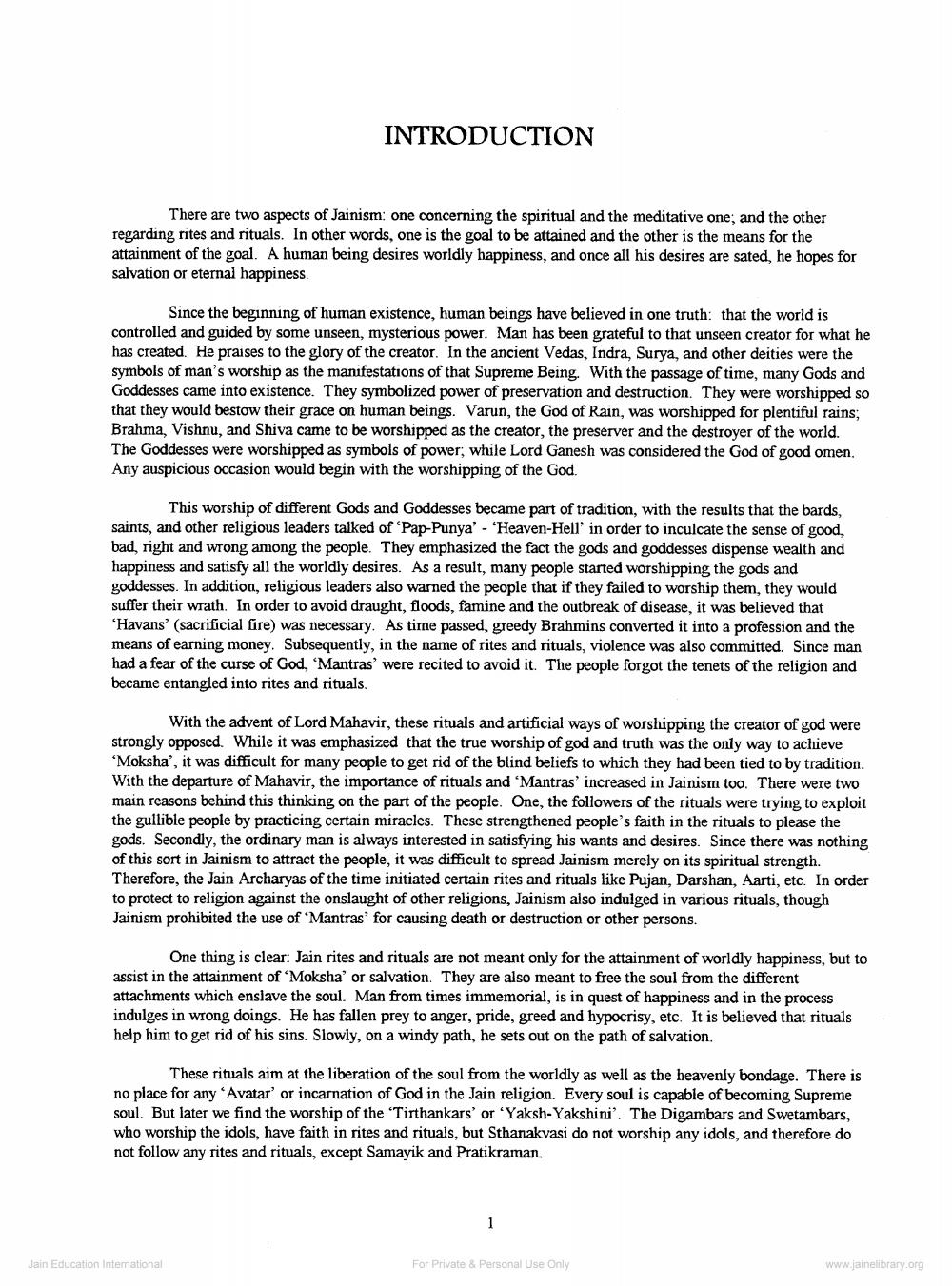Book Title: YJA Convention 1996 07 San Francisco CA Author(s): Young Jains of America (YJA) Publisher: Young Jains of America YJA USA View full book textPage 3
________________ INTRODUCTION There are two aspects of Jainism: one concerning the spiritual and the meditative one, and the other regarding rites and rituals. In other words, one is the goal to be attained and the other is the means for the attainment of the goal. A human being desires worldly happiness, and once all his desires are sated, he hopes for salvation or eternal happiness Since the beginning of human existence, human beings have believed in one truth: that the world is controlled and guided by some unseen, mysterious power. Man has been grateful to that unseen creator for what he has created. He praises to the glory of the creator. In the ancient Vedas, Indra, Surya, and other deities were the symbols of man's worship as the manifestations of that Supreme Being. With the passage of time, many Gods and Goddesses came into existence. They symbolized power of preservation and destruction. They were worshipped so that they would bestow their grace on human beings. Varun, the God of Rain, was worshipped for plentiful rains, Brahma, Vishnu, and Shiva came to be worshipped as the creator, the preserver and the destroyer of the world. The Goddesses were worshipped as symbols of power, while Lord Ganesh was considered the God of good omen. Any auspicious occasion would begin with the worshipping of the God. This worship of different Gods and Goddesses became part of tradition, with the results that the bards, saints, and other religious leaders talked of 'Pap-Punya' - 'Heaven-Hell' in order to inculcate the sense of good, bad, right and wrong among the people. They emphasized the fact the gods and goddesses dispense wealth and happiness and satisfy all the worldly desires. As a result, many people started worshipping the gods and goddesses. In addition, religious leaders also warned the people that if they failed to worship them, they would suffer their wrath. In order to avoid draught, floods, famine and the outbreak of disease, it was believed that 'Havans' (sacrificial fire) was necessary. As time passed, greedy Brahmins converted it into a profession and the means of earning money. Subsequently, in the name of rites and rituals, violence was also committed. Since man had a fear of the curse of God, 'Mantras' were recited to avoid it. The people forgot the tenets of the religion and became entangled into rites and rituals. With the advent of Lord Mahavir, these rituals and artificial ways of worshipping the creator of god were strongly opposed. While it was emphasized that the true worship of god and truth was the only way to achieve Moksha', it was difficult for many people to get rid of the blind beliefs to which they had been tied to by tradition. With the departure of Mahavir, the importance of rituals and Mantras' increased in Jainism too. There were two main reasons behind this thinking on the part of the people. One, the followers of the rituals were trying to exploit the gullible people by practicing certain miracles. These strengthened people's faith in the rituals to please the gods. Secondly, the ordinary man is always interested in satisfying his wants and desires. Since there was nothing of this sort in Jainism to attract the people, it was difficult to spread Jainism merely on its spiritual strength. Therefore, the Jain Archaryas of the time initiated certain rites and rituals like Pujan, Darshan, Aarti, etc. In order to protect to religion against the onslaught of other religions, Jainism also indulged in various rituals, though Jainism prohibited the use of 'Mantras' for causing death or destruction or other persons. One thing is clear: Jain rites and rituals are not meant only for the attainment of worldly happiness, but to assist in the attainment of ‘Moksha' or salvation. They are also meant to free the soul from the different attachments which enslave the soul. Man from times immemorial, is in quest of happiness and in the process indulges in wrong doings. He has fallen prey to anger, pride, greed and hypocrisy, etc. It is believed that rituals help him to get rid of his sins. Slowly, on a windy path, he sets out on the path of salvation. These rituals aim at the liberation of the soul from the worldly as well as the heavenly bondage. There is no place for any 'Avatar' or incarnation of God in the Jain religion. Every soul is capable of becoming Supreme soul. But later we find the worship of the 'Tirthankars' or 'Yaksh-Yakshini'. The Digambars and Swetambars, who worship the idols, have faith in rites and rituals, but Sthanakvasi do not worship any idols, and therefore do not follow any rites and rituals, except Samayik and Pratikraman. Jain Education International For Private & Personal use only www.jainelibrary.orgPage Navigation
1 2 3 4 5 6 7 8 9 10 11 12 13 14 15 16 17 18 19 20 21 22 23 24 25 26 27 28 29 30 31 32 ... 36
